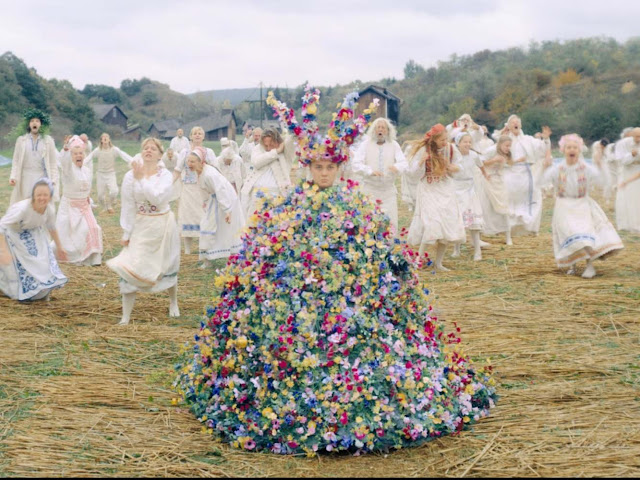Midsommar and the cult of madness
I’ve just watched Midsommar straight after watching Hereditary last night. This morning I wrote a poem about how it made me feel (wake up art I thought you were dead). Essentially the poem is about how I’ve noticed that art is a way we access the excess or the shadow in films. Think about all those serial killer’s sketch pads prepared by the film’s art directors. Hereditary had the sketch books of the Milly Shapiro character and the aesthetic of what turned out to be a cult of Satanists, whereas Midsommar took this much further into a whole complex ritualistic culture of a remote Swedish village. Anyone whose been near to my recent art making will have perhaps picked up my obsession with aesthetic ontology. I like to think that art can speculate about a culture that places feeling at the core – hence aesthetic ontology – this is what the village of Hargar in the film started to represent to me. In this realm, however, we do not abandon reason and our ability to problem solve using information but this process occurs within an aesthetic culture. Ordinarily aesthetic culture is an add on and the excesses that art accesses are beyond the everyday. I like to think that there could be a culture without this split that reason demands. And that’s what brings me back to this movie paradigm that Midsommar almost escapes. Perhaps it does but I’m not sure. The paradigm is that if you abandon reason for feeling then it will lead to terror and suffering. It’s the same premise as the French revolution: Feeling and sensation are shameful and decadent so we need puritanical reason and measurable data to keep us from chaos. Now, of course, the accelerationist differential of social media means that stabilising data is its own kind of chaos).
Midsommar seems to present an aesthetic ontology, which escapes the shame of being human. I was still left feeling like art or aesthetic culture was this dark excess that we delve into at our peril. Again, that split that reason demands we face. Light of dark. Dionysus of Apollo but that very split is derived from classical order. The Greeks and Aristotlyian ringfencing have taken us a long way but when it comes to understanding affect (something referred to in Midsommar a few times) there are limits to what measurable data can tell us. The whiff I got from Midsommar was more attempts of reason to wrestle back power and maintain the outward resemblance of an aesthetic ontology. The fear in this film, which is so brilliantly summoned, is cognition’s fear of the unknown and throughout the plot arc we get this push and pull between academic thinking and indigenous culture’s sense of being part of the land (This dynamic of critical distance and prehensile understanding is also brilliantly explored in Jonathan Miller’s Whistle and I’ll come to you). In one of my lectures on portraits I show the students skulls found in Jericho, which are decorated with cowry shells. I explain that these skulls are cherished objects seeking to keep loved ones in the realm of the living. They are not grisly or morbid artefacts because they are from an aesthetic culture where the divide and separation of enlightened thinking has not been able to separate us from death as part of life. After watching Midsommar I had this brief feeling that I was once again being made by reason to side with the serial killers (It puts it in the basket) and psycho cults because that’s where aesthetic culture leads. Or is it that this is where it leads when reason pretends its not real: superstitious, superfluous, supernatural. Considering the films use of psychedelic substance use to open up habitual modes of thought, it seems apt to bring in Aldous Huxley who said that these prehensile and felt modes of understanding are not supernatural but an expanded form of natural. So, in effect these feelings are my own desire for an aesthetic culture being questioned my own far more reflexive sense of inhabiting a realm of reason. How often have I told myself that due to my deafness I am “unclouded by normal cognition”?

Comments
Post a Comment